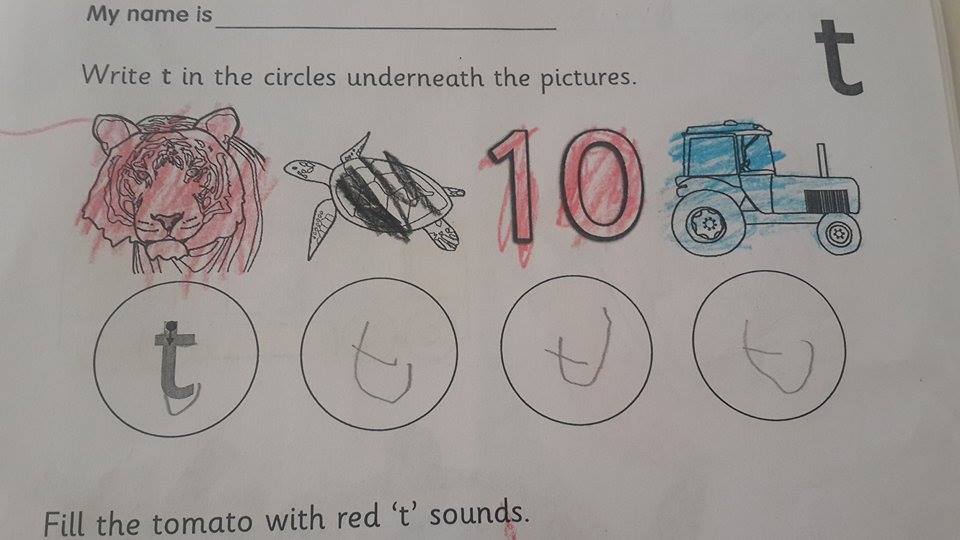Whenever I think that I have seen enough to reaffirm what I believe in what I have been studying and reading throughout the past few years, I am surprised by yet another piece of evidence that keeps me mesmerized and fascinated by the amazing science of Handwriting analysis, the one true collaboration between human’s subconscious and conscious mind.
What I found today was something that answered a question that had been running in the back of my mind for some time now. How would our Brain Writing look like before we begin to realize the right shapes and formations of the letters, before we pay attention to whether it looks good or not, long before we master the writing itself. Can we analyze the primary handwriting of children and be accurate in our assessment of character traits? Do these initial markings on a page mean anything at all?
I wondered how it would look like to write with the subconscious mind being in total control (when the conscious mind is not paying attention to what we are writing). I thought a lot about it, but couldn’t find my way through? I didn’t know that I would see the answer as it was laid in my hands on afternoon.
Here is what was going on…
I was preparing lunch for my 4 years old girl ‘Mariam’ and thinking to myself would she love it, would she not? I was thinking that I should have played it safe this morning and ask her what she would like for lunch, anyways, it was TOO LATE, the doorbell rings and I ran to the door and opened it with a huge grin on my face, welcoming her the way she likes, with a festival like manner.
I took the bag from her hands and asked her how her day was, she replied “fine”. She marched through to the kitchen to see what I had cooked for lunch, then went to her room to see if I changed the castle that she was building last night.
After a 3 minutes tour around the house checking on things and making sure everything was under control, I asked her to go wash her hands and change her clothes, so she could eat her lunch. They say we don’t have democracy! Lol. I opened up her bag to check on what homework she had for the evening and what the letter of the day was. Miriam is in KG1 and is learning to write. That was when I was both shocked and fascinated, with what I have found in her bag.
It was a paper with three ” T” letters on it. It is the day when she met the incredible T letter for the first time, and they were her first attempts to write it. As expected with this amazing letter, it expressed many of her key personality traits, ones that I deal with everyday and struggle to find new ways to make them work for her benefit. I immediately took a snap shot of it with my phone and named it “her Ts says it all”. It is my proof of her early traits and of what she made her parents go through as she grew up. I am hoping and praying that one day when she is a mature adult, she will understand what I will show her, have a good laugh about it, and share some really good stories with her.
I’m going to share with you those letters, with some of my insights about the traits I found in them. I am sure many of you once you see the letters, you will have a smile on your face and think, “may God help you”.
The T bar slanted downward
These T bars indicate someone with a domineering quality, one who likes things to go their way and will not accept it any other way. They could be the trait of a potential leader or someone who needs to be in charge all the time.
Imagine having a four years old with such traits. As much as it can be hard to deal with her behavior sometimes, it gives me joy to see that she is responding to my gentle directions to learn positive behaviors related to this character trait. She is learning to act like a leader among her friends and be positive with relationships with people. It does not come easy and it is an ongoing process that challenges me every day to teach her and keep her on the right path.
Being a dominant personality is not necessarily the result of your actions with your child. It is a combination of environmental and inherited traits. The development of the trait will be largely effected by experiences in life, negative or possitve.
She is domineering to the degree where I cannot teach her something by way of direct instructions, like how to write a number or how to do something. She will interrupt me by saying “no it is not like that let me show you how it’s done”. Seriously, she didn’t learn any dominating traits from any one in our home so it is probably a built-in trait from birth. She has been like that ever since she started to walk and talk.
It can be hard to deal with this trait, but I have learned a few ways in making this into a positive trait, for her sake before anyone else, for it could be the very quality that will give her confidence and become the strong woman that I want her to be as she grows up.
One of the things that I try to teach her is that “if you going to be dominant do so in helping others and in making your environment a better one”. Each day I ask her a question that deals with that area and serves that purpose. She seems to understand these values.
The other day she came to me and told me that some child was crying wanting his mom and that she went to him and calmed him down and made him understand that his mom is at home doing her work once they finish school she will come and get him. so even though she is a dominant in nature, she is learning to use it in a good way.
Brats and bullies have the domineering trait, and most parents are confused about how to deal with it. There is a fine line between making this domineering trait a positive or a negative one. It is as simple as this;
What is important for you is important for your child- Kids are very smart and they constantly test the limits of your authority and the boundries that you place on them. So establish your set of acceptable behaviors for them and stick with them, allowing room for them to learn to make discussions in the process. Set out what the acceptable choices are in any situation and let them exercise some agency of choice.
For example you can let them dress the way they want at home, to choose their own clothes and accessories, but when you go out to a public place, you make sure they understand what acceptable choices are. Let them to choose from a couple sets of cloths that you think are suitable for the situation, as making decisions – small doses of domineering practice- is an important part of developing a mature personality as they grow up.
The T that has a long ending tail
A long up turning terminal stroke on the letter T is an indication of someone who needs and wants attention. I like BART’s phrasing of this trait “as if a child is raising his hands up in a class for attention”. This is true in Mariam’s case as she will ask for and demands attention from those who are around her. On her first day at school she said “I want the teacher to introduce me to the class and say ‘hello everyone, this is your new friend Mariam.’” That did not happen, which caused some problems with her accepting the school at first, until I wrote to her teacher. I shared with her some tips about Mariam, including that she flourishes when she gets attention and positive re-enforcement. Mariam quickly enjoyed going to school every day.
No one taught Miriam to make a long tail at the end of her Ts, but she did it naturally, on her own and in the first attempt at writing. This indicates that the subconscious mind is functioning in its purest form. The behavior on paper coincided perfectly with the character traits of the personality of a young developing mind. Graphology provided the recognition of the subconscious needs and basic needs of a young child in their initial stages of learning to write.
Needing attention is natural for an only child. From my personal experience, I believe that the behaviors that are developed in the early developmental form the basis of their personality as they mature. Giving attention to a child and fulfilling their basic needs, if given at the right time will help them attract that same energy as they grow up, they will naturally draw positive attention to themselves.
The temper T
With the T bar that is written totally to the right side of the steam, it indicates someone with a temper, has emotional control issues and will have the tendency to lose their cool in a moment.
Well if we add up the two traits we have above which is (domineering and needing attention) it’s only natural to have temper as a result, because things doesn’t always goes your way… and people cant always put their focus on you, so temper will catch up with you sooner or later, the question is; do you have the right techniques to deal with it?
Early detection of potentially negative character traits can be lifesaving. The beauty of handwriting analysis is that it allows you to detect the – about to be problem- early before it becomes a serious issue later in life. Discovering early signs of potential temper issues in a child is much easier to deal with than when they are grown adults, for they are more open-minded to learn new things and better ways to deal with their emotional needs. Learning to deal with the issues that are common in social environments and developing strong communication skills (the power of words) is critical in their early years. This is something I have found to be very true as I work with my daughter.
As an example, Miriam would cry for some reason and my response was “crying won’t do you any good, unless you talk to me because I don’t understand what do you want or what the problem is.” Only when she calmed down and speak to me normally, would I interact with her and discuss the issue. She responded well and it’s a great relief for me in that I don’t have to deal with the nonsense behavior of crying. She has learned to communicate effectively and her emotions do not get the best of her now.
The funny thing is that now she uses the same technique on me. When I lose my temper with her she says to me, “I can’t understand you. You need to lower your voice and talk nicely if you may.” My husband would hear such conversations occasionally and says “you brought it on yourself “. The power of words is a way to deal with temper issues.
Those were just few high examples that I wanted to share with you to demonstrate that the subconscious mind is active all the time and will express itself when put a pen to paper. The possibilities on how to deal with what you learn from an analysis is up to you. Graphology is like taking a look at a coded script of a computer, whereas only a trained professional can interpret what it means and have the ability to deal with it efficiently.
In summary, the science of handwriting analysis always provides you with intriguing information even if it is only few strokes of the pen. With these few letters that I saw today from my daughter, it has affirmed to me that that whether you are writing for the very first time in your life or whether you had been writing for the past 20 years, the trait is still the same and won’t compromise for the sake of the duration of your writing experience, your nationality or even your age. It’s a gift for human been, lucky are those who receives it and if you are reading this, you are one of them.
So be happy …and live positively.
Lina Husham, Jordon





Permalink
This is so fascinating!!!
i’m so impressed by this revelation of your little girl’s handwriting
I’m proud of being part of this exposition of knowledge in Handwriting analysis
Long live Handfwriting University
Always the best at our time!!